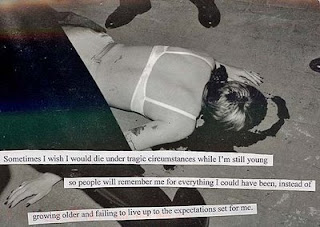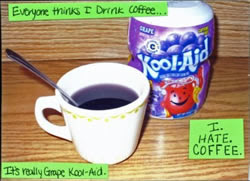A piece of information that I found particularly helpful came on page 60 of Hilliard's Writing for Television, Radio, and New Media. Hilliard states that in writing, it is important to choose words that are familiar to everyone.

This pertains to my interest in advertising and public relations, because of target audiences. When I am writing a press release or creating an advertisement, I want to make sure that I am using simple, straight to the point wording that everyone in my target audience will understand. Hilliard also says to try to find different ways of saying the same thing. Advertising and public relations about about innovation, and finding creative new ways of expressing an idea. Hilliard's statements definitely resinated with me and I could find the connection to my professional field.
2. Cut Through The Clutter
News stations must distinguish their companies. Most news programs have the same information, so how they portray information is a large determining factor of who listens to them. They need to distinguish themselves in order to gain viewers, and even take viewers away from competitors.
 On page 154 of the text, Hilliard states that the competition to gain the most viewers is a rating race. This race forces stations to relay information in interesting ways to differentiate their company from the competition. This market competition can be seen in more industries than simply news stations. Competition in the market fuels the economy, and companies are forced to find unique ways to sell their products.
On page 154 of the text, Hilliard states that the competition to gain the most viewers is a rating race. This race forces stations to relay information in interesting ways to differentiate their company from the competition. This market competition can be seen in more industries than simply news stations. Competition in the market fuels the economy, and companies are forced to find unique ways to sell their products.[Image Source]
3. Listen To The Public Service Announcemnt
Page 73 of the Hilliard text reveals that public service announcements are only aired when all of the commercial spots are not bought. Public service announcements contain important information that people need to hear. Many companies are required to create public service announcements for their business. For example, when tobacco advertising was allowed on television, for every three tobacco advertisements, the tobacco company had to have one anti-smoking public service announcement. Public service announcements often contain more valuable information than regular, propaganda-like messages. Often times, public service announcements are more important than trying to get consumers to buy a miscellaneous product. Here is an example about a public service announcement that has information content that will educate the public on Autism.
4. Documentary v. Feature
An important lesson that I learned from Hilliard was the difference between a documentary and a feature. On page 194 he states that documentaries take a point of view toward the subject matter, while features try to stay unbiased. Features like to give straight forward information that doesn't sway a person's opinion in anyway, instead, it simply educates them on the subject matter. Another difference Hillard points out is that features tend to avoid controversial issues. Documentaries in no way try to avoid controversial issues. Most documentaries are shedding light on an issue that they want to educate the public on. An example of a documentary is Bowling For Columbine, a film created by Michael Moore. This documentary explores what Michael Moore believes are the causes for violence with guns and specifically, the Columbine High School shootings.
5. Bye Bye Passive Voice
Hilliard taught a lesson about writing in a passive voice. He stated on page 355 to use an active voice instead of a passive voice. I never noticed, but I tend to use the passive voice.

An example of this would be, there are 10 posts contained on this blog, rather than saying, this blog contains 10 posts. The first statement is wordy, lengthly, and in the passive voice. The second statement is more direct. This relates back to using simple language. The phrase is more straight forward, and is understood better. Avoiding the passive voice makes sentences more direct.
6. Writing Skills For All Mediums
On page 447, Hilliard brings up the need to be able to write in a variety of forms. He says that it is necessary to be well rounded and to write in a number of media forms. This is something that electronic media writing is all about and Champlain College as well. Nearly every class that I have been enrolled in at Champlain has stressed the importance of being a well rounded individual. Part of being a well rounded individual is being a strong writer for traditional media, like print journalism, but to also be tech savvy and know how to blog and utilize tools such as Twitter. I definitely understand the importance.
[Image Source]
7. Judgment Time
Hilliard talks about censorship and writing with non-offensive content. Page 13 of the text describes how writers must be able to have a talent for writing quality material while using their judgment in the material that they use. It's hard to censor writing for all audiences, especially because of the variety of people that have access to the different mediums. There are things like parental control on television, but that doesn't necessarily mean that a young child can't turn on MTV's Spring Break while flicking through the channels. Writing has to be censored to an extent, and it has regulations that the writing needs to follow. However, I think that writers also have to censor themselves for the benefit of their company. It is easier to write a family sitcom and satisfy the general public than to write for Family Guy, who has a more narrowly define audience and can easily offend people. Even with defined guidelines, some outrageous things can be aired by FCC regulations, but writers may censor themselves further as an act of PR. It's hard to satisfy everyone, but Hilliard states that there has to be some sort of attempt at self censorship in writing.
8. Narrowcasting
Narrowcasting came up on page 3 in the Hilliard text. There has been an increase in television programs with very specific, specialize audiences. However, like I spoke about with revelation 7, a primary aim of video producers is to present material that will not offend anyone. I think that narrowcasting is a way to reach target audiences by avoiding having to use complete censorship. If the audience is completely aware about the material, they can choose not to watch it. There are many controversial television programs that get criticized. One example is Jersey Shore. MTV received a lot of backlash for having this television program, but it was a huge success, and they are creating a second season.
 Another example is Gossip Girl. Gossip Girl was originally a book series. The series have risky material in them as well, so parents who let their children read the books, shouldn't have a problem with the TV show; however, they can research the program and see if it is appropriate for their children. From learning about narrowcasting, I think that it is important to write for a specific audience, but make smart decisions knowing that people outside of the niche may be exposed to the writing as well.
Another example is Gossip Girl. Gossip Girl was originally a book series. The series have risky material in them as well, so parents who let their children read the books, shouldn't have a problem with the TV show; however, they can research the program and see if it is appropriate for their children. From learning about narrowcasting, I think that it is important to write for a specific audience, but make smart decisions knowing that people outside of the niche may be exposed to the writing as well.[Image Source]
9. Children's Programming
Page 381 of the text quotes producer Lucinda Whitely. She is stating that all programming cannot be lollipops and rainbows for children. There has to be a balance of the sweet programming we often see and including challenging issues. Programming is supposed to be educational for children. Yes, it is supposed to be entertaining as well, but the most important aspect is the education. Issue have to be pertinent to children in modern society. Programs often include divorced parents and widowed parents. These types of issues are applicable to nearly 50% of households. Within the programs there are messages about how to deal with these types of problems. Within children's programs there are also messages included for children to pass on to their parents. Recently, a Nickelodeon animated TV show, "Dora The Explorer," promoted the United States Census. It was to promote the importance of including infants and young children on the 2010 United States Census, because recent studies have shown that parents have been excluding children under the age of 5. Television is very influential to young minds, and they absorb the information like a sponge. It is important for writers to use helpful, educational information in the programs. The "Dora The Explorer" example shows the cross over of advertising and television programs.
10. Creativity
Creativity ties into advertising in a major way. I liked how Hilliard stated that creativity cannot be taught. I think that books and education can provide writers with the tools to be successful, but they cannot teach what ideas are going to come out of the writer's head. The tools, such as persuasion techniques, are extremely helpful and stimulate the brain. Education is a process that helps writers gain necessary tools.



























